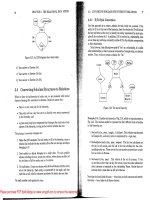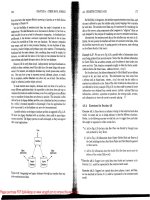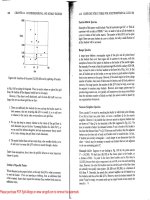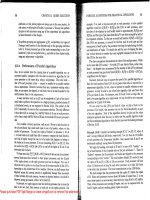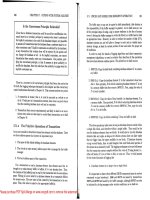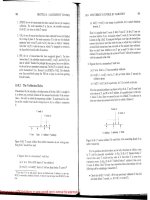the cucumber book
Bạn đang xem bản rút gọn của tài liệu. Xem và tải ngay bản đầy đủ của tài liệu tại đây (6.93 MB, 328 trang )
www.it-ebooks.info
What Readers Are Saying About
The Cucumber Book
Few tools have managed to bridge the developer-customer divide as well as
Cucumber has. Cucumber is not a tool for testing applications. Cucumber is a
philosophy for communicating requirements. This book brings that philosophy
to life.
➤
Robert C. Martin (Uncle Bob)
I devoured the Cucumber book on a train ride from Grenoble to Brussels a few
days after watching Matt’s presentation “BDD As It’s Meant to Be Done.” These
two resources helped me understand in just a few hours how to avoid dozens of
common mistakes writing scenarios in the Cucumber style. It’s as though I received
an injection of perhaps two years of experience writing scenarios poorly so that I
didn’t have to go through it all myself. What a gift. I recommend this book to
everyone working with Cucumber.
➤
J. B. Rainsberger
Author, JUnit Recipes
www.it-ebooks.info
Teams can use Cucumber to get a better understanding of what software to build
for their customers. In this book, Aslak and Matt do a brilliant job explaining how
you get started with Cucumber with plenty of easy-to-follow examples.
➤
Rachel Davies
Author, Agile Coaching
To those of you wondering how to use Cucumber effectively, The Cucumber Book
is the answer. Not content to write just a testing book, Aslak and Matt have packed
it with practical insights on many aspects of software development. Studying this
book will make you a better software developer.
➤
Pat Maddox, B.D.D.M.F.
RSpec Core team
This is a much-needed book, providing not only an expanded description of how
to use Cucumber but an opinionated one to suggest how to use it for the best effect.
Reading this book is like having Aslak and Matt sitting next to you, patiently
helping you through your first project with Cucumber. Not only will you learn
effective use of Cucumber, but you’ll also be introduced to several other Ruby
tools that can be used with Cucumber.
➤
George Dinwiddie
Software development coach at iDIA Computing, LLC
www.it-ebooks.info
Matt and Aslak show you how Cucumber can save you from stale documentation,
unclear requirements, and absentee tests. By the end of the book, your team’s
programmers, testers, and product owners will be talking excitedly about the next
great product you’re going to build together.
➤
Ian Dees
Author, Scripted GUI Testing with Ruby
This book had me at “Cucumber is designed to help build bridges between the
technical and nontechnical members of a software team.” Wynne and Hellesøy
understand the whole-team approach to specification by example, with diverse
team members collaborating to deliver what the customer really wants. They use
examples to teach us how to automate regression checks with Cucumber, use it
to build a safety net to allow refactoring, and free testers to contribute their most
valuable skills to the team.
➤
Lisa Crispin
Author, Agile Testing: A Practical Guide for Testers (with Janet Gregory)
This book is a tale of how to do effective acceptance testing, with Cucumber as
the filling in the sandwich. The authors don’t just scratch the surface; they get
right under the skin and show us how versatile Cucumber can be.
➤
Robert Chatley
Principal, Devlogical
www.it-ebooks.info
Lots of great tips for Cucumber newbies and experts alike—Matt and Aslak have
done a great job of explaining everything from getting started to how to get the
most out of Cucumber. You’ll want to read this book cover to cover and keep it
close as a reference!
➤
Gojko Adzic
Author, Specification by Example and Bridging the Communication Gap
The Cucumber Book is a must-read for anyone thinking about using Cucumber;
it is scattered with treasures for even the most experienced Cucumber users.
➤
Antony Marcano
RiverGlide
www.it-ebooks.info
The Cucumber Book
Behaviour-Driven Development
for Testers and Developers
Matt Wynne
Aslak Hellesøy
The Pragmatic Bookshelf
Dallas, Texas • Raleigh, North Carolina
www.it-ebooks.info
Many of the designations used by manufacturers and sellers to distinguish their products
are claimed as trademarks. Where those designations appear in this book, and The Pragmatic
Programmers, LLC was aware of a trademark claim, the designations have been printed in
initial capital letters or in all capitals. The Pragmatic Starter Kit, The Pragmatic Programmer,
Pragmatic Programming, Pragmatic Bookshelf, PragProg and the linking g device are trade-
marks of The Pragmatic Programmers, LLC.
Every precaution was taken in the preparation of this book. However, the publisher assumes
no responsibility for errors or omissions, or for damages that may result from the use of
information (including program listings) contained herein.
Our Pragmatic courses, workshops, and other products can help you and your team create
better software and have more fun. For more information, as well as the latest Pragmatic
titles, please visit us at
.
The team that produced this book includes:
Jackie Carter (editor)
Potomac Indexing, LLC (indexer)
Kim Wimpsett (copyeditor)
David J Kelly (typesetter)
Janet Furlow (producer)
Juliet Benda (rights)
Ellie Callahan (support)
Copyright © 2012 Pragmatic Programmers, LLC.
All rights reserved.
No part of this publication may be reproduced, stored in a retrieval system, or
transmitted , in any fo rm , or by any means, electro ni c, mechanical, p ho to cop yin g,
recording, or otherwise, without the prior consent of the publisher.
Printed in the United States of America.
ISBN-13: 978-1-934356-80-7
Printed on acid-free paper.
Book version: P1.0—January 2012
www.it-ebooks.info
Contents
Foreword . . . . . . . . . . . . . xiii
Acknowledgments . . . . . . . . . . . xv
Preface . . . . . . . . . . . . . . xvii
Part I — Cucumber Fundamentals
1. Why Cucumber? . . . . . . . . . . . . 3
Automated Acceptance Tests 41.1
1.2 Behaviour-Driven Development 4
1.3 Living Documentation 6
1.4 How Cucumber Works 7
1.5 What We Just Learned 8
2. First Taste . . . . . . . . . . . . . 11
Understanding Our Goal 112.1
2.2 Creating a Feature 12
2.3 Creating Step Definitions 14
2.4 Implementing Our First Step Definition 16
2.5 Running Our Program 17
2.6 Changing Formatters 18
2.7 Adding an Assertion 19
2.8 Making It Pass 20
2.9 What We Just Learned 23
3. Gherkin Basics . . . . . . . . . . . . 25
What’s Gherkin For? 253.1
3.2 Format and Syntax 28
3.3 Feature 29
3.4 Scenario 30
3.5 Comments 33
www.it-ebooks.info
3.6 Spoken languages 34
3.7 What We Just Learned 35
4. Step Definitions: From the Outside . . . . . . . 39
Steps and Step Definitions 404.1
4.2 Capturing Arguments 45
4.3 Multiple Captures 49
4.4 Flexibility 50
4.5 Returning Results 52
4.6 What We Just Learned 58
5. Expressive Scenarios . . . . . . . . . . 61
Background 615.1
5.2 Data Tables 64
5.3 Scenario Outline 70
5.4 Nesting Steps 75
5.5 Doc Strings 78
5.6 Staying Organized with Tags and Subfolders 79
5.7 What We Just Learned 82
6. When Cucumbers Go Bad . . . . . . . . . 85
Feeling the Pain 866.1
6.2 Working Together 89
6.3 Caring for Your Tests 97
6.4 Stop the Line and Defect Prevention 105
6.5 What We Just Learned 106
Part II — A Worked Example
7. Step Definitions: On the Inside . . . . . . . . 111
Sketching Out the Domain Model 1127.1
7.2 Removing Duplication with Transforms 117
7.3 Adding Custom Helper Methods to the World 120
7.4 Organizing the Code 128
7.5 What We Just Learned 131
8. Support Code . . . . . . . . . . . . 133
Fixing the Bug 1348.1
8.2 Bootstrapping the User Interface 141
8.3 Making the Switch 142
8.4 Using Hooks 147
Contents • ix
www.it-ebooks.info
8.5 Building the User Interface 150
8.6 What We Just Learned 154
9. Dealing with Message Queues and Asynchronous
Components . . . . . . . . . . 157
9.1 Our New Asynchronous Architecture 157
9.2 How to Synchronize 158
9.3 Implementing the New Architecture 161
9.4 Fixing the Flickering Scenario 165
9.5 What We Just Learned 171
10. Databases . . . . . . . . . . . . . 173
Introducing ActiveRecord 17410.1
10.2 Refactoring to Use a Database 175
10.3 Reading and Writing to the Database 178
10.4 Cleaning the Database with Transactions 181
10.5 Cleaning the Database with Truncation 185
10.6 What We Just Learned 186
Part III — Cucumber Applied
11. The Cucumber Command-Line Interface . . . . . 191
Cucumber’s Command-Line Options 19111.1
11.2 Running a Subset of Scenarios 192
11.3 Changing Cucumber’s Output 194
11.4 Specifying the Location of Step Definitions 196
11.5 Managing Your Work in Progress (WIP) 197
11.6 Using Profiles 198
11.7 Running Cucumber from Rake 198
11.8 Running Cucumber in Continuous Integration 199
11.9 What We Just Learned 200
12. Testing a REST Web Service . . . . . . . . 201
12.1 In-Process Testing of Rack-Based REST APIs 202
12.2 Out-of-Process Testing of Any REST API 213
12.3 What We Just Learned 220
13. Adding Tests to a Legacy Application . . . . . . 221
Characterization Tests 22213.1
13.2 Squashing Bugs 224
13.3 Adding New Behavior 225
Contents • x
www.it-ebooks.info
13.4 Code Coverage 227
13.5 What We Just Learned 227
14. Bootstrapping Rails . . . . . . . . . . 229
Running the Generators 23014.1
14.2 Creating a User 232
14.3 Posting a Message 236
14.4 Associating a Message with a User 239
14.5 Creating a Controller by Hand 240
14.6 Implementing the View 242
14.7 What We Just Learned 243
14.8 Try this 244
15. Using Capybara to Test Ajax Web Applications . . . . 245
Implementing a Simple Search Without Ajax 24715.1
15.2 Searching with Ajax 257
15.3 The Capybara API 268
15.4 Taking Screenshots 271
15.5 What We Just Learned 272
16. Testing Command-Line Applications with Aruba . . . 275
Simple Interfaces 27516.1
16.2 Our First Aruba Feature 276
16.3 Working with Files and Executables 280
16.4 Interacting with User Input 288
16.5 Using Aruba’s Ruby DSL 291
16.6 What We Just Learned 292
A1. Using Cucumber with Other Platforms . . . . . . 295
A2. Installing Cucumber . . . . . . . . . . 299
Installing Ruby 299A2.1
A2.2 HTTP Proxy Settings 300
A2.3 Installing Bundler 301
A2.4 Installing Cucumber (and RSpec) 301
A2.5 Installing Other Gems 301
A2.6 Choosing a Text Editor 302
A3. Ruby Gem Versions . . . . . . . . . . 303
A4. Bibliography . . . . . . . . . . . . 305
Index . . . . . . . . . . . . . . 307
xi • Contents
www.it-ebooks.info
Foreword
Behaviour-driven development has come a long way since I first started
talking about it in 2003. At that time, I was simply trying to find better ways
to explain the revelatory practice of TDD, usually to nervous, suspicious, or
at the very least skeptical programmers. Why would you write tests ahead of
any code? That didn’t make sense. And why were we writing tests anyway—
don’t we have testers for that?
Very few things represent a genuine paradigm shift. Mostly the term is used
by marketers to convince you to change your brand of toothpaste. According
to the Free Online Dictionary, a paradigm
1
is “A set of assumptions, concepts,
values, and practices that constitutes a way of viewing reality for the commu-
nity that shares them.” That’s right, a paradigm shift involves messing with
someone’s sense of reality! No wonder they get uncomfortable.
TDD is one of those rare genuine cases, so it’s no surprise that many people
are deeply skeptical when you start trying to introduce it. And it’s also not
surprising that it took us several attempts at articulating it, in different ways,
from different angles, and with different audiences, before we found something
that worked. At first we started deep in the code, because that’s where the
programmers were. Over time we were able to take the action closer to the
business stakeholders and describe the multilayered approach that is modern
BDD (and is also, ironically, classic TDD, which Kent Beck described from
the very outset as working on multiple levels of abstraction).
Aslak Hellesøy has been part of the effort to describe that shift almost from
the very beginning. As well as an early adopter of BDD—and a passionate
advocate of TDD—he rewrote my sad efforts at building a scenario runner for
RSpec into the tool we now call Cucumber. He has invested enormous time
and effort into both the tool and its community, so it came as no surprise to
learn he and Matt were writing a book on BDD in Cucumber. I love that they
1. />report erratum • discuss
www.it-ebooks.info
are targeting both developers and testers. If the tool isn’t bringing these two
worlds closer together, then it’s the wrong tool.
I was delighted to learn that Aslak’s partner in crime would be Matt Wynne.
Another passionate and experienced TDDer—and BDDer—Matt has been
involved with Cucumber since day one. He is a fun and engaging speaker, is
a great teacher, and has a wealth of knowledge and wit that comes across in
his writing. In fact, I’m proposing that Matt Wynne be inaugurated as a unit
of excellence, somewhere between a Win and an Epic Win. (Oh, cool, did you
see that? That was better than a win; that was a Matt Wynne!)
I hope you enjoy this book as much as I did. My review notes from an earlier
draft seem to contain the phrase “Oh, this is lovely” more times than I remem-
bered. It feels like you are being led into a strange, yet somehow oddly familiar,
wo rld with two know led gea ble and acc omm odati ng gui des. O odles of ex amp les ,
descriptions, and sidebars (Joe—who you’ll meet early on—quickly became
my friend by asking the things I found myself asking.) help you on your way,
and the authors manage to keep the plot moving quickly enough to keep you
engaged, which is always a challenge in a technical book.
I can’t say where BDD will be in another eight years, but with folks like Matt
and Aslak sharing their innovation and clarity, now is a very exciting time to
be involved in agile software development.
—Dan North, Lean technology specialist at DRW Trading and originator of BDD
xiv • Foreword
report erratum • discuss
www.it-ebooks.info
Acknowledgments
The first people we want to thank are the hundreds of you who contribute to
the Cucumber community. Whether you’re sharing ideas, experiences, and
opinions on the mailing list, helping people in the IRC channel, or contributing
new features and bug fixes to the codebase, it all helps. Without your contri-
bution, there would be no Cucumber and therefore no book.
Writing this book has taken much more effort than either of us had anticipat-
ed. Throughout it all, our editor Jackie Carter has patiently been there at our
side, cajoling us when we needed it, chiding us when we deserved it, and
giving us thoughtful feedback at every opportunity. Jackie has made a massive
contribution to the quality of what you’re reading, and her name fully deserves
its place on the cover.
Thanks to our reviewers:
George DinwiddieLasse Koskela
Ian DeesRachel Davies
Robert ChatleyArti Mathanda
Luis LavenaKevin Rutherford
Crain RieckeGojko Adzic
Mike SassakSean Miller
Your suggestions and encouragement were greatly appreciated.
Thanks to all the beta readers who left us feedback, helping us iron out the
little mistakes we would never have seen ourselves.
Thanks to Dan North for his enthusiastic and generous foreword. Matt blames
Dan for introducing him to the idea of BDD, and it was his experiments with
JBehave and RBehave that caused Aslak to create Cucumber in the first
place. Dan has a lot to answer for.
From Matt: I want to thank the team at Songkick, especially Sabrina Leandro,
Niko Felger, Dan Lucraft, Phil Cowans, and Matt Johnson. Many of the lessons
report erratum • discuss
www.it-ebooks.info
in this book I learned with you. Greatest thanks go to my wonderful wife,
Anna, for believing in this project and giving me the support I needed to actu-
ally get it done. Imagine all the things we’ll be able to do now that it’s finished!
From Aslak: Dad, thanks for having the foresight to buy me a Commodore
64 in 1981. Patricia, my dear wife—thank you for the countless hours of
patience and encouragement. And for coming up with the silly but catchy
name Cucumber!
xvi • Acknowledgments
report erratum • discuss
www.it-ebooks.info
Preface
Cucumber is a friendly tool. It wants to be part of your team, and it doesn’t
mind being the nitpicky nerd who can remember every single little detail about
what your system can and can’t do. Every team needs someone like that.
Even better than that, Cucumber will volunteer to do all the boring repetitive
checks that you need to run to make sure that the system is working as
expected. This frees your testers up to do interesting, creative work instead,
and it gives programmers the courage to perform major surgery to the code
when it’s required. Business stakeholders warm to Cucumber’s open attitude,
sharing everything that the development team is doing in terminology that
they can actually understand.
Cucumber is a young tool, but it’s already become clear that some people
misunderstand it. Those of us who were drawn to Cucumber from the begin-
ning instinctively realized that it’s more than a testing tool; it’s a collaboration
tool. By writing this book, we hope to show you not just how to use Cucumber
but how to use it well.
Who This Book Is For
Cucumber is designed to help build bridges between the technical and non-
technical members of a software team, and we’ve tried to consider both of
those readers. The majority of the book is written to the technical reader,
someone who is interested in test automation and already has at least some
programming skill. However, several of the chapters—especially in the first
part of the book where we explain how to write the specifications themselves
—are written with the nontechnical reader very much in mind. Specifically,
those chapters are as follows:
• Chapter 1, Why Cucumber?, on page 3
• Chapter 3, Gherkin Basics, on page 25
• Chapter 5, Expressive Scenarios, on page 61
report erratum • discuss
www.it-ebooks.info
• Chapter 6, When Cucumbers Go Bad, on page 85
• Chapter 13, Adding Tests to a Legacy Application, on page 221
As the book develops, we’ll look at more complex testing situations, and the
level of technical know-how required to read the chapters will increase. We’ve
tried to make this buildup as gradual as possible so that if you’re only just
beginning your journey into test automation, you should be able to follow
along and learn as we go.
You Don’t Need to Know Ruby, But It Helps
Ruby
1
is an open source programming language that can be installed and
run on all major operating systems. The original—and still most popular—
version of Cucumber is written in Ruby, and this book is about that version.
That doesn’t mean the system you’re testing has to be written in Ruby. One
of Ruby’s many strengths is how good it is at talking to other languages and
platforms, and we’ll show you how to use Ruby tools to test web-based systems
that could be written in any language.
To follow along with the coding examples in the technical chapters, it will
help if you know a little Ruby. Ruby is an easy language to learn, and the
Ruby examples we’ll use are deliberately simple. To get the best out of this
book, we suggest that Ruby novices accompany it with a copy of Everyday
S c ri p ti ng wit h R ub y [M ar07] or P r og r am m in g R uby : T he P ra gma ti c Pr og ram me r ’s
Guide [TFH08].
It’s OK if You’re Not Test-Driven
We’ve had our greatest success with Cucumber as part of an outside-in
approach, starting with a failing Cucumber test and using that to drive our
development work on the application code. As developers, this way of working
helps us stay honest and avoid the temptation to build in functionality that
nobody asked us for, just in case it might be needed one day in the future.
Cucumber is a tool that facilitates this way of working, but it doesn’t force it
on you. Some teams use Cucumber to automate tests for the work that devel-
opers have already done. This can often be a first step toward adopting an
outside-in approach, as Cucumber’s readable tests start to attract the atten-
tion of the team’s nontechnical stakeholders, drawing them into the process.
Even if you’re using Cucumber to write tests against existing code, you’ll still
get a great deal of benefit from Cucumber over alternatives like QTP and
1.
xviii • Preface
report erratum • discuss
www.it-ebooks.info
Selenium IDE, and we think you’ll still get a lot out of this book. We’re not
here to preach to you about process, but we will share our insights about
what has worked for us and why.
Why You Should Listen to Us
We’ve both been building software for a living for almost twenty years, and
using automated tests for nearly ten of those. Aslak created Cucumber in
2008, and Matt has been one of its most active users from day one.
We’ve used Cucumber to test all kinds of systems: from Ruby on Rails web
applications, through Flash games, to enterprise Java web services. We’ve
also trained hundreds of developers in how to use Cucumber, teaching the
material in this book at events and companies around the world.
The Cucumber community is full of lively debate, and we’ve spent many hours
of our spare time having our ideas challenged and honed in discussions with
other users. We hope we’ve distilled as much of that knowledge and experience
as possible in this book.
How This Book Is Organized
The book is in three parts. In Part I, we’ll take you through the core concepts
you need to know in order to make use of Cucumber. Novice readers will learn
everything they need to know to get up and running, and readers who are
already experienced with Cucumber should pick up plenty of useful detail
too.
Part II works through a practical example of developing a new application
using Cucumber. You’ll pair with us as we build a simple application from
scratch, giving you a chance to experience how we like to build software using
Cucumber and to consolidate what you’ve learned in Part I. We’ll also teach
you some advanced features of Cucumber that are easier to learn in the
context of an example.
Cucumber provides the framework for specifying and executing tests, but
there are a wide variety of systems that you might want to test. In Part III,
we’ve provided you with a broad selection of guides to using Cucumber in
some common situations, such as testing REST APIs, Ajax web applications,
and command-line applications.
What Is Not in This Book
Although it is possible to test Flash and mobile applications using Cucumber,
the details are sadly beyond the scope of this edition. Similarly, the flavors
report erratum • discuss
Why You Should Listen to Us • xix
www.it-ebooks.info
of Cucumber that run natively on the JVM, JavaScript and C#, allowing you
to write your Cucumber code in the same language as your production code,
will not be covered. Cucumber’s wire protocol (a protocol for driving remote
systems over a TCP socket) is also out of scope.
We have provided a list of pointers to further information on this subject in
Appendix 1, Using Cucumber with Other Platforms, on page 295. For further
information about using Ruby to automate and test different kinds of system,
we recommend getting a copy of Scripted GUI Testing with Ruby [Dee08] by
Ian Dees to compliment our book.
Running the Code Examples
This book is full of practical examples, and we encourage you to follow along
with them to get the most out of the book. You’ll learn the most if you type
them in by hand as you read along, but if you’d prefer, you can always
download the code examples from />source_code.
To run the examples, you’ll need to install the Ruby language itself as well
as some additional libraries, which in Ruby are called gems. You can find the
full instructions in Appendix 2, Installing Cucumber, on page 299.
Windows Users
Most of the code examples work just the same on Windows and *nix operating
systems. On the rare occasions that they differ, you’ll find the Windows version
in a sidebar nearby, with a note in the body of the text pointing you to the
sidebar.
You’ll soon notice that we’ve used the
$
symbol for the command prompt.
This is familiar to Linux or Mac users but might feel a little unfamiliar to
Windows users. So, when you’re looking at something like this:
$ cucumber
try to imagine you’re seeing this instead:
C:\> cucumber
Other than that, everything should work just the same for everyone.
Getting Help
If you’re stuck on one of the exercises in this book, there is a discussion forum
where you can ask for help at />xx • Preface
report erratum • discuss
www.it-ebooks.info
If you have a general question about Cucumber, the Cucumber community
will welcome you to their mailing list at />#!forum/cukes. Cucumber is an open source tool, which means that everyone
contributing to the group is volunteering their time, so please make sure
you’ve researched your question as thoroughly as you can before you ask for
help on the mailing list. People will be much more likely to help you if they
can see you’re trying to help yourself.
report erratum • discuss
Getting Help • xxi
www.it-ebooks.info
Part I
Cucumber Fundamentals
www.it-ebooks.info
CHAPTER 1
Why Cucumber?
Software starts as an idea.
Let’s assume it’s a good idea—an idea that could make the world a better
place, or at least make someone some money. The challenge of the software
developer is to take the idea and make it real, into something that actually
delivers that benefit.
The original idea is perfect, beautiful. If the person who has the idea happens
to be a talented software developer, then we might be in luck: the idea could
be turned into working software without ever needing to be explained to
anyone else. More often, though, the person with the original idea doesn’t
have the necessary programming skill to make it real. Now the idea has to
trav el from t ha t p er so n’s m in d into ot he r p eo pl e’s. It n eeds to b e c om mu ni c at ed .
Most software projects involve teams of several people working collaboratively
together, so high-quality communication is critical to their success. As you
probably know, good communication isn’t just about eloquently describing
your ideas to others; you also need to solicit feedback to ensure you’ve been
understood correctly. This is why agile software teams have learned to work
in small increments, using the software that’s built incrementally as the
feedback that says to the stakeholders “Is this what you mean?”
Even this is not enough. If the developers spend a two-week iteration imple-
menting a misunderstanding, not only have they wasted two weeks of effort,
but they’ve corrupted the integrity of the codebase with concepts and func-
tionality that do not reflect the original idea. Other developers may have
already innocently started to build more code on top of those bad ideas,
making it unlikely they’ll ever completely disappear from the codebase.
We need a kind of filter to protect our codebase from these misunderstood
ideas.
report erratum • discuss
www.it-ebooks.info
1.1 Automated Acceptance Tests
The idea of automated acceptance tests originates in eXtreme Programming
1
(XP), specifically in the practice of Test-Driven Development
2
(TDD).
Instead of a business stakeholder passing requirements to the development
team without much opportunity for feedback, the developer and stakeholder
collaborate to write automated tests that express the outcome that the
stakeholder wants. We call them acceptance tests because they express what
the software needs to do in order for the stakeholder to find it acceptable. The
test fails at the time of writing, because no code has been written yet, but it
captures what the stakeholder cares about and gives everyone a clear signal
as to what it will take to be done.
These tests are different from unit tests, which are aimed at developers and
help them to drive out and check their software designs. It’s sometimes said
that unit tests ensure you build the thing right, while acceptance tests ensure
you build the right thing.
Automated acceptance testing has been an established practice among good
XP teams for years, but many less experienced agile teams seem to see TDD
as being a programmer activity only. As Lisa Crispin and Janet Gregory point
out in Agile Testing: A Practical Guide for Testers and Agile Teams [CG08],
without the business-facing automated acceptance tests, it’s hard for the
programmers to know which unit tests they need to write. Automated accep-
tance tests help your team to focus, ensuring the work you do each iteration
is the most valuable thing you could possibly be doing. You’ll still make mis-
takes—but you’ll make a lot less of them—meaning you can go home on time
and enjoy the rest of your life.
1.2 Behaviour-Driven Development
Behaviour-Driven Development
3
(BDD) builds upon Test-Driven Development
(TDD) by formalizing the good habits of the best TDD practitioners. The best
TDD practitioners work from the outside-in, starting with a failing customer
acceptance test that describes the behavior of the system from the customer’s
point of view. As BDD practitioners, we take care to write the acceptance tests
as examples that anyone on the team can read. We make use of the process
of writing those examples to get feedback from the business stakeholders
about whether we’re setting out to build the right thing before we get started.
1. Extreme Programming Explained: Embrace Change [Bec00]
2. Test Driven Development: By Example [Bec02]
3. />4 • Chapter 1. Why Cucumber?
report erratum • discuss
www.it-ebooks.info
As we do so, we make a deliberate effort to develop a shared, ubiquitous lan-
guage for talking about the system.
Ubiquitous language
As Eric Evans describes in his book Domain Driven Design [Eva03], many
software projects suffer from low-quality communication between the domain
experts and programmers on the team:
“A project faces serious problems when its language is fractured. Domain experts
use their jargon while technical team members have their own language tuned
for discussing the domain in terms of design Across this linguistic divide, the
domain experts vaguely describe what they want. Developers, struggling to under-
stand a domain new to them, vaguely understand.”
With a conscious effort by the team, a ubiquitous language can emerge that
is used and understood by everyone involved in the project. When the team
uses this language consistently in their conversations, documentation, and
code, the friction of translating between everyone’s different little dialects is
gone, and the chances of misunderstandings are greatly reduced.
Cucumber helps facilitate the discovery and use of a ubiquitous language
within the team, by giving the two sides of the linguistic divide a place where
they can meet. Cucumber tests interact directly with the developers’ code,
but they’re written in a medium and language that business stakeholders
can understand. By working together to write these tests—specifying collabo-
ratively—not only do the team members decide what behavior they need to
implement next, but they learn how to describe that behavior in a common
language that everyone understands.
When we write these tests before development starts, we can explore and
eradicate many misunderstandings long before they ooze their way into the
codebase.
Examples
What makes Cucumber stand out from the crowd of other testing tools is that
it has been designed specifically to ensure the acceptance tests can easily be
read—and written—by anyone on the team. This reveals the true value of
acceptance tests: as a communication and collaboration tool. The easy read-
ability of Cucumber tests draws business stakeholders into the process,
helping you really explore and understand their requirements.
Here’s an example of a Cucumber acceptance test:
report erratum • discuss
Behaviour-Driven Development • 5
www.it-ebooks.info
Feature: Sign up
Sign up should be quick and friendly.
Scenario: Successful sign up
New users should get a confirmation email and be greeted
personally by the site once signed in.
Given I have chosen to sign up
When I sign up with valid details
Then I should receive a confirmation email
And I should see a personalized greeting message
Scenario: Duplicate email
Where someone tries to create an account for an email address
that already exists.
Given I have chosen to sign up
But I enter an email address that has already registered
Then I should be told that the email is already registered
And I should be offered the option to recover my password
Notice how the test is specified as examples of the way we want the system
to behave in particular scenarios. Using examples like this has an unexpect-
edly powerful effect in enabling people to visualize the system before it has
been built. Anyone on the team can read a test like this and tell you whether
it reflects their understanding of what the system should do, and it may well
spark their imagination into thinking of other scenarios that you’ll need to
consider too. Gojko Adzic’s book Specification by Example [Adz11] contains
many case studies of teams who have discovered this and used it to their
advantage.
Acceptance tests written in this style become more than just tests; they are
executable specifications.
1.3 Living Documentation
Cucumber tests share the benefit of traditional specification documents in
that they can be written and read by business stakeholders, but they have a
distinct advantage in that you can give them to a computer at any time to tell
you how accurate they are. In practice, this means that your documentation,
rather than being something that’s written once and then gradually goes out
of date, becomes a living thing that reflects the true state of the project.
6 • Chapter 1. Why Cucumber?
report erratum • discuss
www.it-ebooks.info

